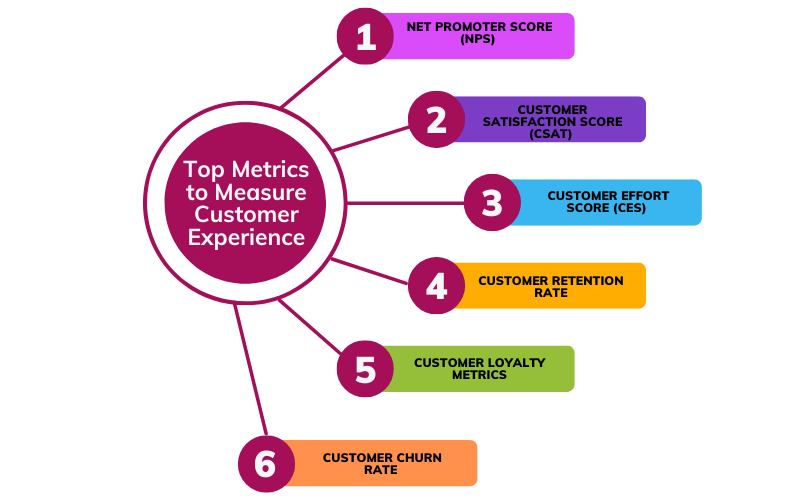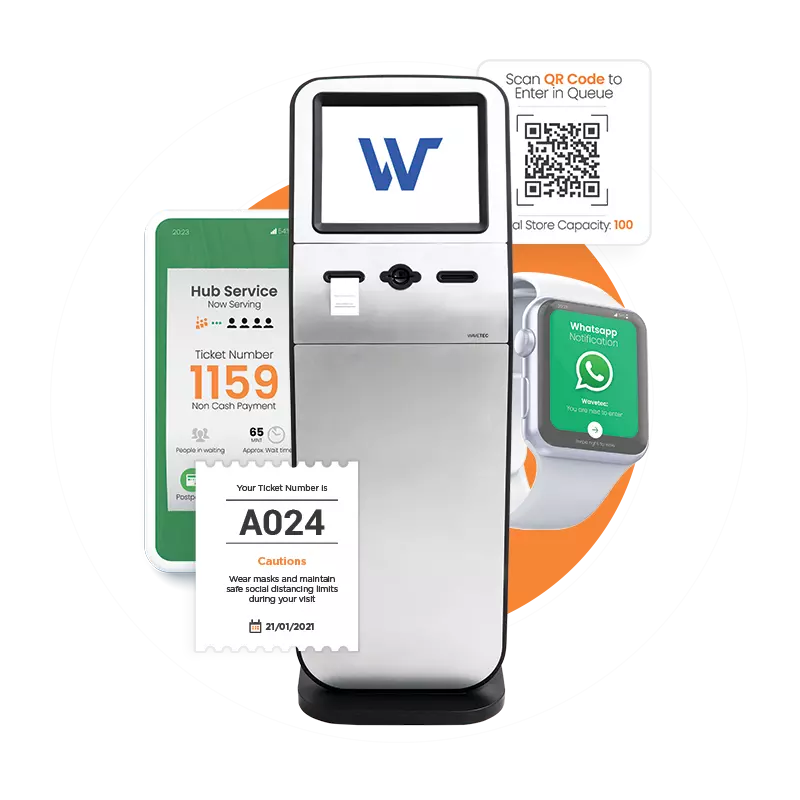Measuring and improving customer experience is vital for any business aiming to gain a competitive edge in a crowded marketplace.
A positive customer experience promises increased loyalty and retention rates, leading to a 25-95% higher ROI.
Conversely, poor customer experience can reduce retention by up to 67% and implement a negative brand image, significantly lowering ROI. This is why customer experience tracking is crucial.
Businesses can measure customer experience through online surveys, metrics analysis, and dashboards with KPIs like customer satisfaction score, churn rate, net promoter score, and social media sentiments.
Progressing these KPIs improves customer experience, thus promoting faster business growth.
This is why understanding how to measure customer experience is crucial for any business aiming to succeed in today’s market. We’ll explore this topic today.
From looking into the most effective customer experience measurement tools to pinpointing the key metrics that drive success, you’re in the perfect place to learn everything you need to improve your strategies and achieve outstanding customer experience results.
What is Customer Experience
In today’s highly populated marketplace, customers have various alternatives to buy anything from desired brands and various resources to make an informed purchase decision.
Turning their buyer journey seamless and hassle-free is mandatory to keep prospects intact and interested in your brand, products, and services. It helps you build rapport with your customers and retain them as loyal customers for future sales and word-of-mouth marketing.
Top Metrics to Measure Customer Experience
 Measuring the customer experience is essential for any business looking to improve service quality and augment customer satisfaction. Here are the top metrics that provide the most insightful feedback.
Measuring the customer experience is essential for any business looking to improve service quality and augment customer satisfaction. Here are the top metrics that provide the most insightful feedback.
1.Net Promoter Score (NPS)
The Net Promoter Score (NPS) is a popular metric used to gauge customer loyalty and is essential to measuring the customer experience. It measures how likely customers are to recommend a company’s products or services to others.
Customers rate their likelihood on a scale from 0 to 10. Based on their responses, they are categorized as promoters (9-10), passives (7-8), or detractors (0-6). A high NPS indicates strong customer loyalty and a positive customer experience.
Companies use this score to evaluate how their products or services stand in the market and how to measure customer experience effectively.
2. Customer Satisfaction Score (CSAT)
The Customer Satisfaction Score (CSAT) measures customers’ satisfaction with a specific interaction or overall company experience. This score directly reflects how to evaluate customer experience.
Customers are typically asked to rate their satisfaction on a scale from 1 to 5 or 1 to 10. High CSAT scores suggest that customers are happy with the service or product they received, positively impacting the company’s approach to measuring customer experience.
This metric helps businesses understand customer satisfaction at a basic level and adjust their strategies accordingly.
3. Customer Effort Score (CES)
The Customer Effort Score (CES) measures how easily customers interact with a company and resolve their issues.
In customer experience measurement, assessing the effort customers put in is crucial. Customers rate the ease of their experience on a scale from 1 to 7.
Lower scores indicate that customers found the process easy, improving their overall experience.
High effort can negatively impact customer satisfaction, so reducing customer effort is critical to improving customer experience tracking and maintaining positive relationships with customers.
4. Customer Retention Rate
The Customer Retention Rate is a vital metric in customer experience evaluation. It measures the percentage of customers who continue to do business with a company over a specific period.
High retention rates indicate that customers are satisfied and less likely to switch to competitors.
This metric helps businesses understand the effectiveness of their customer experience measurement strategies and identify areas for improvement.
Keeping customers coming back is a clear sign that the company is successful in measuring customer experience and providing value to its customers.
5. Customer Loyalty Metrics
Customer Loyalty Metrics include measures that show customers’ loyalty to a brand. These metrics, crucial in measuring the customer experience, can include repeat purchase rates, frequency of interactions, and the overall value of a customer’s relationship with the company.
High loyalty metrics suggest customers have positive experiences and are deeply committed to the brand. These metrics are fundamental in understanding how to quantify customer experience and guaranteeing that customers feel valued and understood.
6. Customer Churn Rate
The Customer Churn Rate measures the percentage of customers who stop doing business with a company over a specific period. High churn rates can indicate issues with the customer experience, such as dissatisfaction with products or services.
Monitoring churn rates are a significant part of customer experience measurement tools, as it helps businesses identify and address issues proactively to retain customers.
This metric is critical to understanding how to measure customer experience and taking steps to improve customer relationships and reduce turnover.
How to Measure Customer Experience?

Understanding and measuring customer experience is crucial for any business aiming to thrive in today’s competitive landscape.
By adopting various customer experience measurement tools and techniques, companies can gain valuable insights into how customers perceive their brands and services. Here’s how you can start measuring the customer experience effectively.
1. Embrace Real-time Feedback and Monitoring
Adopting real-time feedback is critical to effectively measuring customer experience. This involves using surveys, feedback forms, and monitoring social media to hear what customers say.
Real-time feedback offers immediate insights into what customers think and feel about your service, allowing you to fix any problems quickly.
Tools like live chat and automated feedback requests are great for gathering this information efficiently. By staying on top of customer feedback, you can improve the customer experience tracking process and ensure your customers are always heard.
2. Adopt Customer Journey Analytics
Adopting customer journey analytics is a powerful way to measure customer experience. This method maps out the entire customer journey, from the first contact to post-purchase interactions.
By examining each touchpoint, you can pinpoint where customers face difficulties and how to improve these areas.
This complete view helps you understand how interactions affect the overall experience.
With this knowledge, you can make informed decisions to enhance the customer journey, utilizing customer experience measurement to foster a better understanding of your customers’ needs.
3. Implement Predictive Analytics
Implementing predictive analytics can significantly enhance your approach to measuring customer experience. This technique uses past data and machine learning to foresee future customer behaviors and preferences.
With predictive analytics, you can predict what customers might need next and solve problems before they arise. This proactive approach improves the customer experience by ensuring that customers receive personalized and timely support.
By predicting future trends, you’re not just reacting but actively improving how to measure customer experience for better satisfaction and loyalty.
4. Integrate Voice of the Customer (VoC) with Voice of the Business (VOB)
Integrating the Voice of the Customer (VoC) with the Voice of the Business (VOB) is crucial for measuring customer experience effectively.
This integration merges customer feedback with business performance data, providing a complete view of how customer experiences affect your business.
By combining VoC and VoB, you can make strategic decisions that boost the customer experience and drive business growth.
This holistic approach ensures that customer experience evaluation aligns with your business objectives, helping you to optimize both customer satisfaction and business outcomes.
5. Implement Customer Segmentation and Personalization
Implementing customer segmentation and personalization is essential to improving customer experience measurement. This process involves dividing customers into groups based on shared traits like demographics or behaviors.
Understanding these segments allows you to tailor experiences to meet specific needs, making customers feel valued and understood. Personalization can include customized marketing, product recommendations, and support services.
This targeted approach is vital to customer experience measurement. It ensures that each customer has a unique and positive experience with your brand. Personalizing your services enhances customer satisfaction and loyalty.
How to measure customer experience – FAQs
How do you measure good customer service experience?
Measuring good customer service experience involves using various metrics and tools to evaluate how customers perceive their interactions with a company.
Key metrics include Net Promoter Score (NPS), Customer Satisfaction Score (CSAT), and Customer Effort Score (CES). Additionally, gathering real-time feedback and monitoring social media mentions can provide valuable insights into the quality of customer service.
What is a CX measurement framework?
A CX measurement framework is a structured approach to evaluating customer experience. It involves using a combination of metrics, feedback mechanisms, and analytical tools to assess and improve CX.
Conclusion
Measuring customer experience is about understanding and improving how we interact with customers. But how to measure customer experience?
Businesses should regularly update their strategies, train employees, and follow industry standards. Technology like AI and analytics helps gain deeper insights into customer behavior, leading to more intelligent decisions.
Listening to customer feedback helps create products that meet their needs, sparking innovation. Keeping a consistent experience across all contact points also builds trust and loyalty.
By focusing on these areas, businesses can develop a solid plan to develop customer experience and achieve lasting success.

